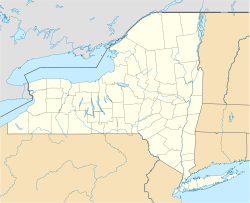- Moravian mission at Shekomeko
-
Moravian mission at Shekomeko — Mission station — Coordinates: 41°55′42″N 73°35′56″W / 41.9283358°N 73.5987854°WCoordinates: 41°55′42″N 73°35′56″W / 41.9283358°N 73.5987854°W Country USA State New York Founded 1740 Disbanded 1746 Founder Christian Henry Rauch The Moravian mission at Shekomeko was founded in 1740 by Christian Henry Rauch to convert the Mahican Indians in eastern New York.
Contents
Background
In the late 1730s the Moravian Church established their first missionary efforts in North America near Bethlehem, Pennsylvania. The Moravian Church had been founded during the 15th century in Bohemia and Moravia. Following almost total destruction in the Thirty Years' War and Counter Reformation, it had been revived in the 1720s under the guidance of Nicolas Ludwig Zinzendorf on his Herrnhut estate in Saxony The Moravian Bishop August Gottlieb Spangenberg sent Christian Henry Rauch to New York City in 1740 on a mission to preach and convert any native peoples he could find. Rauch arrived in New York on July 16, 1740 and met with a delegation of Mahican Indians to settle land issues. The Mahicans were a native Algonquian tribe and branch of the Lenni Lenape or Delaware Nation populated the east bank of the Hudson River in what is today eastern Dutchess County, New York, and western Connecticut.[1]
Establishment
Rauch convinced the delegation of his serious intention to instruct them teach them and Mahican Chiefs Tschoop and Shabash invited Rauch to visit their Dutchess County village. In September 1740 they led him through the unbroken wilderness to Shekomeko. There, Rauch established a Moravian mission and the two Indians chiefs were converted to the Moravian faith. In January 1742, Rauch accompanied Shabash, Seim, and Kiop on a journey to the Pennsylvania community for their baptism. Rauch's first convert Chief Tschoop, was lame and unable to make the journey. Upon their baptism the three were given the Christian names of Abraham, Isaac and Jacob. After the group returned to Shekomeko, Tschoop was baptized as John on April 16, 1742.
By summer 1742, Shekomeko was established as the first native Christian congregation in America.[citation needed] On November 1, 1742, missionary Gottlob Buettner brought his wife to the mission. At the end of 1742, another missionary, Martin Mack, and his wife, Jeannette Rowe, joined the missionary effort. Rauch visited Bethlehem and returned in early 1743 with his new wife. Two more missionaries each with their wives followed soon after.
On March 13, 1743, the distribution of Holy Communion marked a milestone in the development of the Indian congregation. In July 1743, a Moravian chapel was built and dedicated at Shekomeko. By the end of 1743, the congregation of baptized Indians numbered 63. Two satellite missionary outposts were established in Kent, Connecticut and on the New York - Connecticut border.
Difficulties
The increasing Moravian influence and success in defending their burgeoning following became disturbing to the region's white colonists. False rumors of atrocities were spread, some fearful settlers had left their farms and the authorities were petitioned to intervene. Resentment by European settlers in the area quickly grew. The Moravian missionaries exposed traders illegally selling alcohol to the natives and provided legal advice that kept them from being cheated. Many whites resented the missionaries interfering with "nature taking its course."
The Moravian missionaries were repeatedly detained, interrogated, fined and released. Governor George Clinton summoned the Moravians to account for their missionary activities. Alleged to be Papist and conspiring with the outlawed Roman Catholic order of Jesuits, the Moravians successfully defended themselves and were exonerated when no link to the Jesuits could be found. However, they were admonished to cause no further suspicions.
The settlers' enmity for the Moravians continued to grow. They persisted to oppose the Shekomeko mission and were determined to eradicate it. A law was enacted on September 21, 1744 forbidding anyone from residing with Indians in order to Christianize them. The Moravian mission was finally doomed when the provincial assembly adopted a law on September 22, 1744 that required anyone choosing to live among the Indians to take an Oath to the Crown, obtain consent of the council and obtain a license from the Governor to do so; Moravian religious principles forbade taking oaths.
On October 27, 1744 the governor ordered the Moravian missionaries to "desist from further teaching and depart the province". Then on December 15, 1744, the sheriff and three peace officers of Dutchess County appeared at Shekomeko under orders from Governor Clinton to give the missionaries notice to cease their teachings. The Moravian leaders were summoned to appear in court at Poughkeepsie.
Closure
The Moravians missionary venture was maintained sporadically for several years. In 1746 area settlers petitioned the governor to issue to them a warrant authorizing the killing of Shekomeko Indians. While the petition was not granted, upon hearing about the call for their extermination, the last ten families of 44 persons, all that remained of the original 8,000 member tribe 100 years before, left Shekomeko and dispersed into extinction.[2]
See also
External links
References
- A History of the Hamlet of Bethel in the Town of Pine Plains, New York The Little Nine Partners Historical Society (1996, 2008)
- ^ Newton Duel, Elizabeth Klare, James Mara, Helen Netter, Dyan Wapnick, Out of the Wilderness: A History of the Hamlet of Bethel in the Town of Pine Plains, New York (1996), Section 5: "The Moravian Mission"
- ^ PHILIP H. SMITH, "PINE PLAINS", GENERAL HISTORY OF DUCHESS COUNTY FROM 1609 TO 1876, INCLUSIVE, PAWLING, NY: 1877, accessed 3 Mar 2010
Categories:- Populated places in New York
- Pre-state history of New York
- History of the America (North) Province of the Moravian Church
- 1740 establishments
Wikimedia Foundation. 2010.

